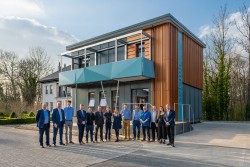The Seismic demonstrator is the culmination of a four-year project developed by a consortium comprising consultancy blacc, offsite manufacturers Elliott Group and the McAvoy, Tata Steel, the Manufacturing Technology Centre (MTC), the National Composite Centre (NCC) and Specific (part of Swansea University).
Designed in line with the government's Construction 2025 targets, it exceeds them in every way, delivering a building that is 75% faster to complete, 70% lower in carbon impact and 47% better value than traditional construction. One of the unique aspects of the project is the combination of three manufacturers working independently on the same building. The demonstrator shows this to good effect incorporating systems from McAvoy, Elliott Group and Tata Steel.
Richard Crosby, Director at blacc, said: "Seismic was developed to help drive a shift towards modern methods of construction (MMC) in the industry. What the consortium has achieved demonstrates the value of a standardised, platform-based approach to construction. It is faster at every stage, from design through to manufacturing, assembly and fitout, and offers better quality and value, alongside a dramatically lower carbon impact. Seismic sets the template for a platform-based approach to construction and proves that it can be done now. This offers a huge opportunity for unlocking development, providing a solution for a range of sectors, including education, healthcare, workplace, leisure and residential."
Seismic has been worked on in two stages. Phase one was developed in response to work with the Department for Education (DfE) to improve the delivery of schools. It focused on the design of a standardised, lightweight steel frame and connector and was completed in 2020. Because of its success, a second stage was commissioned. The objective was to design and construct core components that would work with the frame system, including wall, floor, ceiling and roof cassettes, offering an 'all-in-one' solution for clients.
Sam Stacey, Challenge Director for Transforming Construction, said: "Most modular construction relies on bespoke systems created by individual manufacturers. A lack of standardisation means that different systems are incompatible, which adds risk for clients, especially once they take on responsibility for the building's operation and maintenance. What Seismic shows is that if everyone works to one system it is possible to deliver buildings much more effectively, whether compared with existing modular techniques or traditional construction."
The National Composites Centre (NCC) was appointed to analyse and recommend the best materials to be used for the platform. It also developed a window shroud which was used within the demonstrator building. This supported a wider package of work led by Specific, part of Swansea University, to assess the carbon impacts of Seismic. This looked at the whole process including design, materials, manufacturing, component performance and logistics.
The analysis showed that a standard Seismic module comprises 581.3 kgCO2e per m2, well below Construction 2025's target of 1,300 kgCO2e per m2. And, because Seismic can be reused, either by relocating modules to other sites or by refurbishing individual components and cassettes, it adds a 234 kgCO2e per m2 clawback. This brings Seismic well beyond even the lowest stretch targets being discussed in construction today.
People can visit the demonstrator building at BRE Watford until the end of the year. To find out more visit: www.seismicgroup.co









